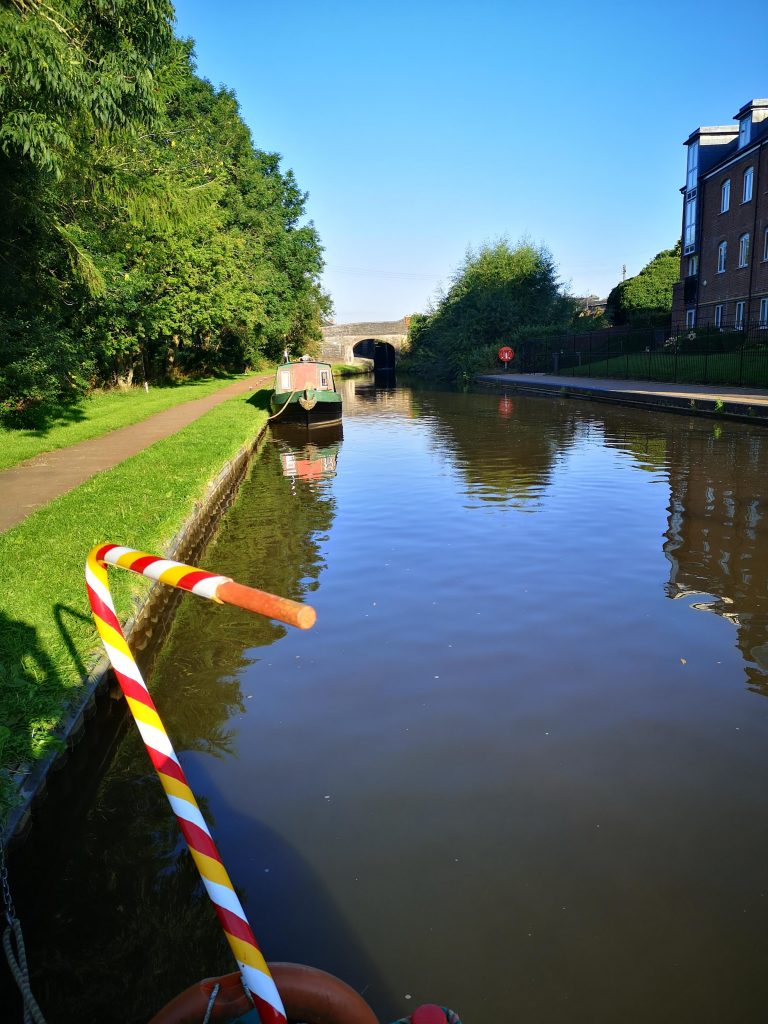
Laundry challenge
It’s funny the things gongoozlers* ask about boat life, the standard is, ‘Isn’t it cold in winter?’ and many have a romanticised image of life on the waterways. To be fair they probably share the same ideas I had when I bought the boat – an idyllic sunshiny world, where mermaids sing and dolphins leap. Though one obnoxious man pressed his nose to Pea Green’s window and snidely asked, ‘Do you sleep in that?’. Unfortunately, at the time, I was trading and wearing my best public persona which stopped me telling him where to go. Personally, I don’t struggle with the winter cold – the boat is much warmer than the house, my biggest everyday challenge is more mundane. It is the simple issue of clothes, doing the laundry and launderettes.
Mini wardrobe of clothes
I have never been particularly interested in clothes. Obviously, I wear them, but I have never enjoyed clothes shopping nor drawn-out procrastination over what to wear. As a result, extended periods living on a very small boat are ideal. Quite simply there is no space for lots of clothes and my wardrobe is very basic. I use the term ‘wardrobe’ loosely, as onboard my clothes are stored in a plastic storage box and on three coat hangers.
Added to the small clothing collection are the daily challenges of single-handed life on a narrow boat. I spend a lot of time fixing stuff, painting canal art, climbing slimy lock-ladders and squeezing past oily lock mechanisms. (Not to mention the muddy pawed dogs allowed to jump up me by their house dwellers humans.) All of this has a bearing on what I wear. Personally, I am incredulous when I see women, on narrow boats, who appear to be dressed for a day at Ascot races.
Clothes choices
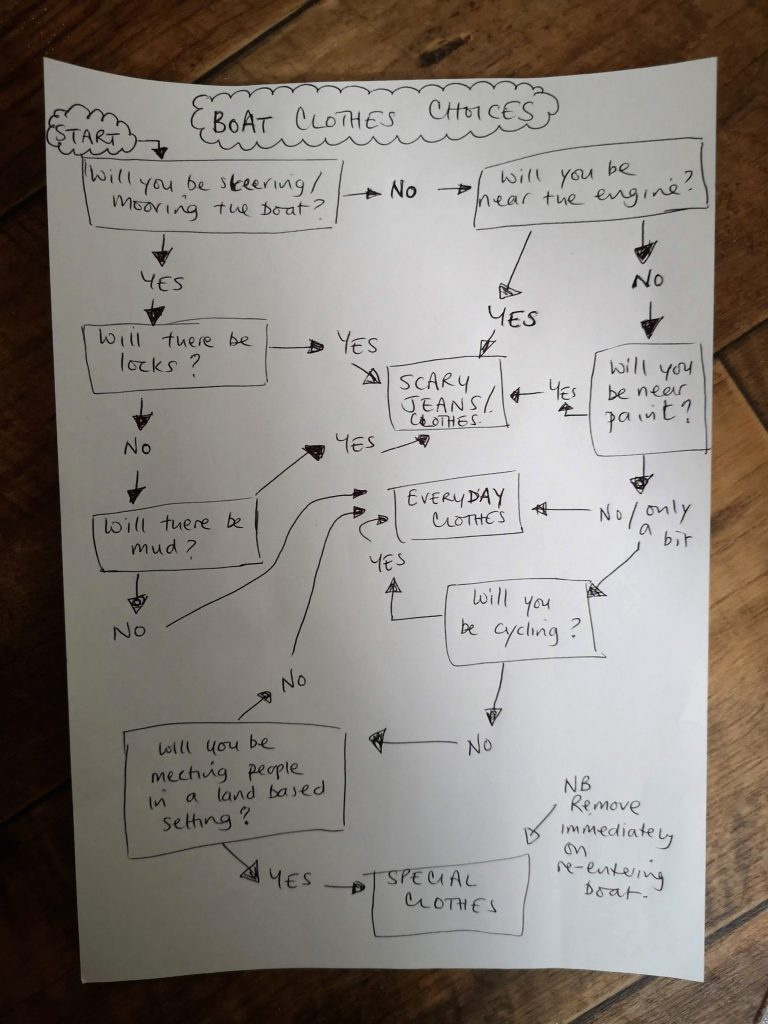
The result of the limited wardrobe, plus the environment, plus my work as a canal artist has led to a clothes choice flow diagram. Garments are categorised into ‘special’, ‘everyday’ and ‘scary ’. Basically, ‘special clothes’ hardly see the light of day. These are kept for the ultimate best, usually that one occasion every 5 months when I leave the boat to go for a meal with another person. (After all I don’t want to embarrass friends.) Special clothes are put on in the 30 seconds before I step off the boat, and removed in the 30 seconds after I return.
Next, are ‘everyday clothes’ these are generally a bit paint splattered, but it’s not too noticeable. They are worn for going to the shops on my bike, or trading or lurking on the boat, or if I go to a pub or café alone. (The latter is a very rare occurrence.)
Finally there are clothes that rank as ‘scary’. These particular items have drawn looks of fear from fellow boaters and gongoozlers alike. The scary jeans and shirts are patched, very stained with oil/paint/stuff and are worn whenever the boat is moved, and are essential if I am navigating locks. The look of this clothing is one reason why I tend to move the boat before anyone else is around
Morning move
Generally, I move the boat early in the morning. This is for a number of reasons, including avoiding the shame of my shabby clothes. Additionally, I have terrible mooring anxiety. As a result I am fearful of not finding a spot to moor, so I usually arrive in a new place just as ‘normal’ people are untying their boats and setting off. Finally, I am usually on a mission to paint, or go food shopping or finding more stock, or trying to find a launderette.
Onboard laundry
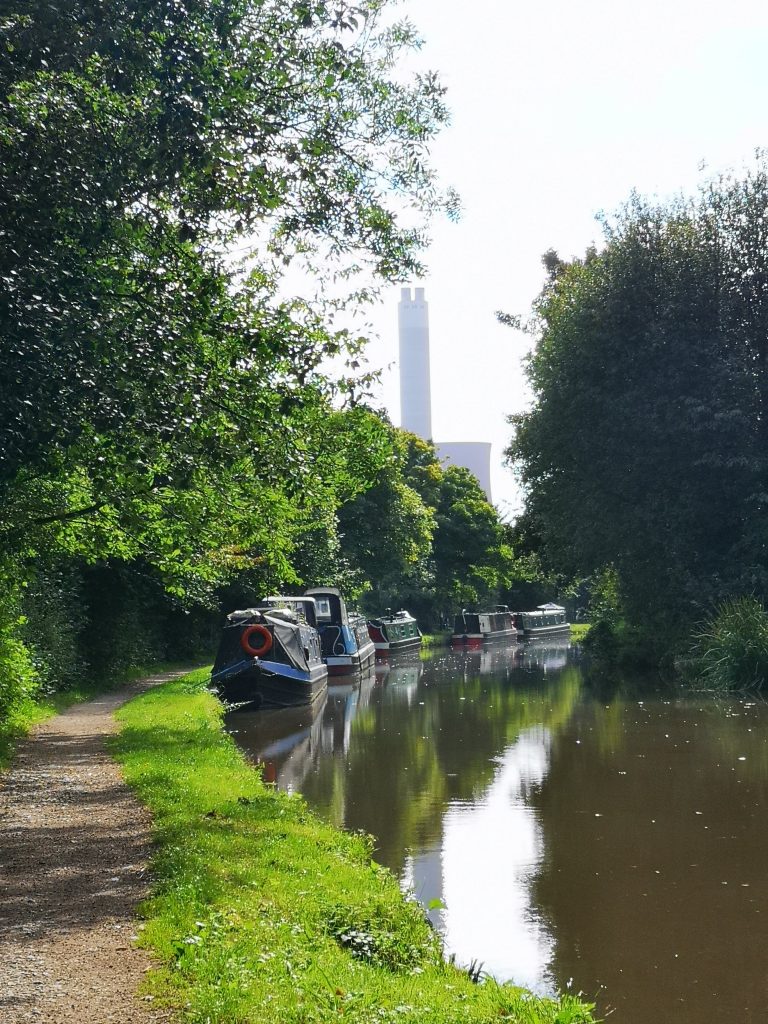
My clothes choices are partly due to not having a washing machine onboard. I only have a bucket for handwashing clothes and a couple of airing racks. The latter hang off Pea Green’s rails for drying clothes. Most of the time this washing/drying regime is fine for clothes, but totally impossible for sheets and duvet covers. To begin with there isn’t room to wring sheets out by hand. Secondly, sheets are too big for the drying racks.
Towpath tyranny
Most of the time the bucket/airer regime works well, but last year I did have a drying ‘incident’. Having washed my clothes I had clipped the racks on the towpath side of the boat and pegged out my wet laundry. I was busy inside and hadn’t taken any notice of a distant motor sound growing every closer. Finally, I did notice, and as I stuck my head out of the hatch I saw the towpath contractor.
The contractor, on a ride on mower, was making a super-efficient job of cutting the grass, soil and dog poo. Plus, the machine had the bonus feature of flailing the towpath debris all over my newly washed wet clothes hanging on the side of the boat. At this point I bore an uncanny resemblance to the angry emoji…. The bloke on the mower seeing my face and probably lip-reading my comments over the noise of the engine, made a fast exit towards the nearest road bridge.
Finding a launderette
Occasionally, I do find a launderette, though the process is akin to a military operation. First, the launderette has to be identified and located on a map, then I work out the closest mooring spot. Mooring proximity is essential as I have a large bag of laundry, plus detergent and fabric softner and sacks of coins for the machines, all of which have to be carried or strapped precariously to my bike and reach the launderette.
Mountains of Stoke
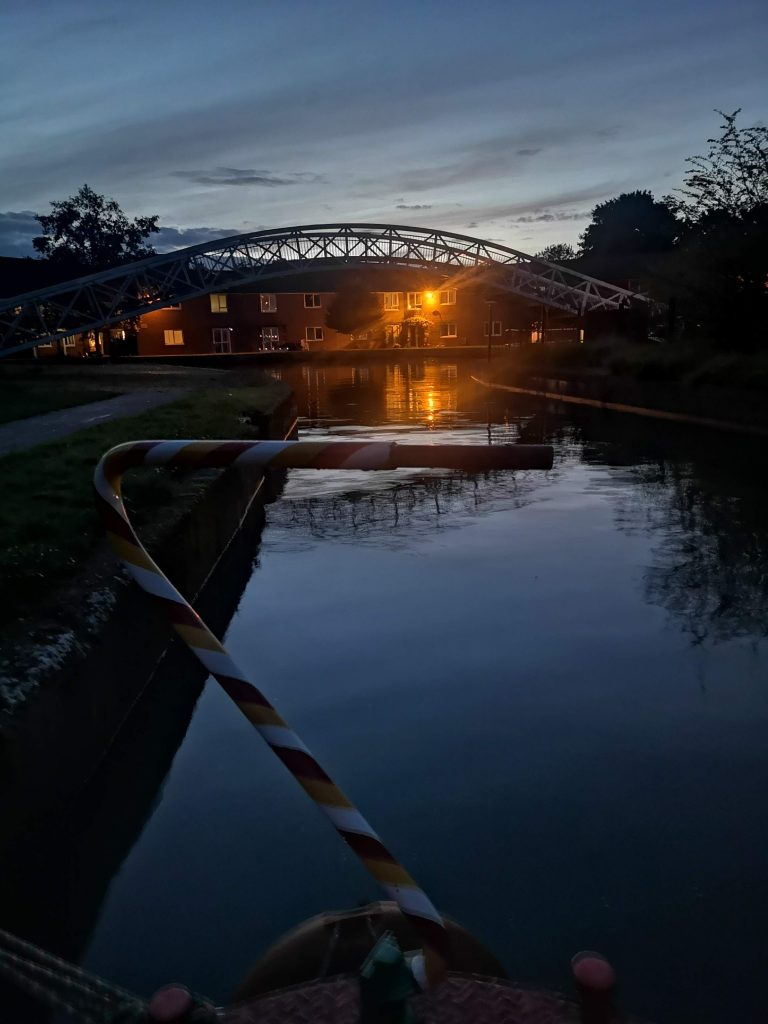
The internet/map search usually works, the exception being in Stoke on Trent. I must admit I felt a little smug, having found a laundry only 15 mins walk from the bottom of the Caldon canal. Plus, the most recent laundry review (who’d have thought such things existed?) was added only a month earlier, so all looked promising. My smugness grew as I sneakily squeezed into the last mooring spot on the Caldon, before I bagging my clothes for the laundry. In a howling gale I hauled my laundry, inside out umbrella and related stuff towards the launderette.
Doing the laundry and launderette fail…
After 30 minutes, not the suggested 15, of what felt like a Himalayan mountain climb I stood, in driving rain, outside the launderette. It was closed, and judging by the filthy windows, knee-high pile of post and flyers on the door mat, it had been shut for months. My self-satisfaction was now replaced with self-fury that I had not called ahead. (And, additional anger at the bogus review.)
The laundry hike continues
I pulled out my phone and began a frenetic search for another launderette. This was further hindered as without my glasses I couldn’t see the keyboard. Despite my impaired vision I found another launderette in Stoke. However according to Google maps it was a further 30 minutes walk, but by this point I decided I had to go for it.

Google maps can be invaluable, especially for local services from the boat. Unfortunately the downside is, unlike Ordinance Survey, it doesn’t show contours, nor is it linked to the Met Office. As a result I was left dragging my bags of clothes up, down and back up Stokes mountainous terrain in the continuing hurricane winds and horizontal rain.
Joining the laundry zombies
Finally, after what felt like a blind-folded expedition up Mont Blanc, I found the launderette. Once inside, out of the storm, I immediately began to steam dry. A gaggle of laundry zombies, hypnotised by the heat and clothes flying around the dryers, hardly noticed my arrival. The launderette itself was a 1960’s chrome and Formica pastel treat, everything gleaming and very clean.
Degree in washing machines needed
The next challenge was to work the machines. I have learnt it is pot luck whether launderettes have an attendant to supply change and explain the vagaries of the washers. I am constantly astounded by the challenge of operating them. Some require the money first, then the frantic pressing of buttons, in others it is the reverse. It is traumatic, with the social embarrassment of looking an idiot in front of the other laundry zombies. Plus, the language of the washers always leaves me perplexed – I have never unravelled the meaning of ‘Permanent Press’.
Parallel universe of launderettes
The role of other laundry zombies has become problematic during the pandemic. In the summer of 2020 England was in the weird ‘open/closed / be worried’ stage. Face coverings were compulsory in shops and when walking into pubs or restaurants. Yet, laundries were clearly inhabiting a parallel universe. None of the other laundry zombies wore masks, and there was little regard for personal space. In fact, it was as though entering a laundry meant time travelling through a portal into a pre-Covid era. I must admit I found myself giving pointed ‘Paddington stares’ and being annoyed.
The weirdest moment took place in Stoke’s pastel laundry. The launderette was not very big and already had more of us laundry zombies than Covid restrictions permitted. Despite this a young woman accompanied by a similarly aged man flung the door open and barged through the zombies. The couple parked themselves on a bench, pulled on very large headphones and began a strange seated dance. Ten minutes later they upped and left without a word.
Laundry attendants
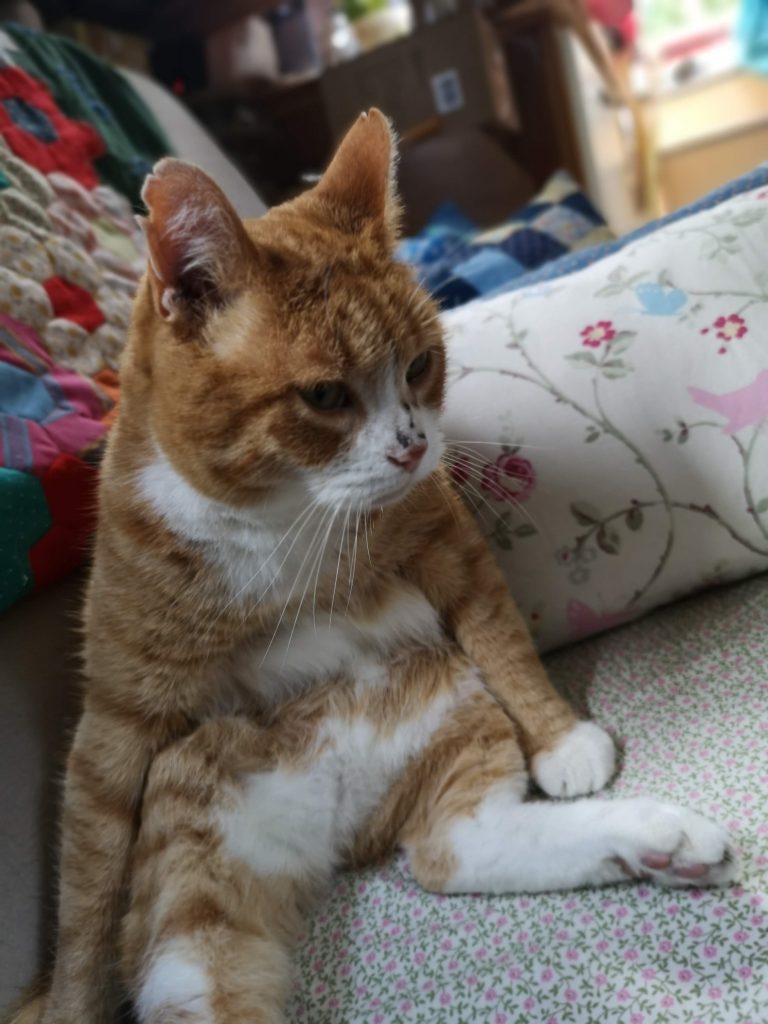
Sometimes there are laundry attendants to help with the machines, service washes and change. Before canal life my only regular experience of launderettes and attendants was when living in LA. There my trips to the ‘lavanderia’ gave an opportunity to improve my Spanish with the attendants. Here in the UK my interaction with the attendants feels more like a scene from Eastenders. Invariably needing change I interrupt the attendant as they chuff through a cigarette in the doorway. Then there are the soap-opera worthy rows over service washes. In one blazing row a woman tried to draw me into her – very loud – argument with the attendant. The customer was fuming over her still wet pillows. ‘Feel this,’ she yelled and pushed a pillow at me, I backed off, feeling more annoyed about the customer’s lack of a mask.
The joy of the north
The further north I headed along the canals the cheaper the launderettes became. Plus they had the added bonus of large spin dryers so cutting down on dryer time. (This was a very exciting feature, when you anticipate spending half a day in a launderette!) Additionally, there were laundries in most towns I passed through. I became giddy knowing I could machine wash clothes every week. This was the opposite of my journey down the Oxford Canal in 2019 where I struggled to find any launderettes at all. The further south I ventured the rarer they became and increasingly expensive. I resorted to loading my bike in a precarious manner to find somewhere to wash my clothes.
The whiff of the pump-out
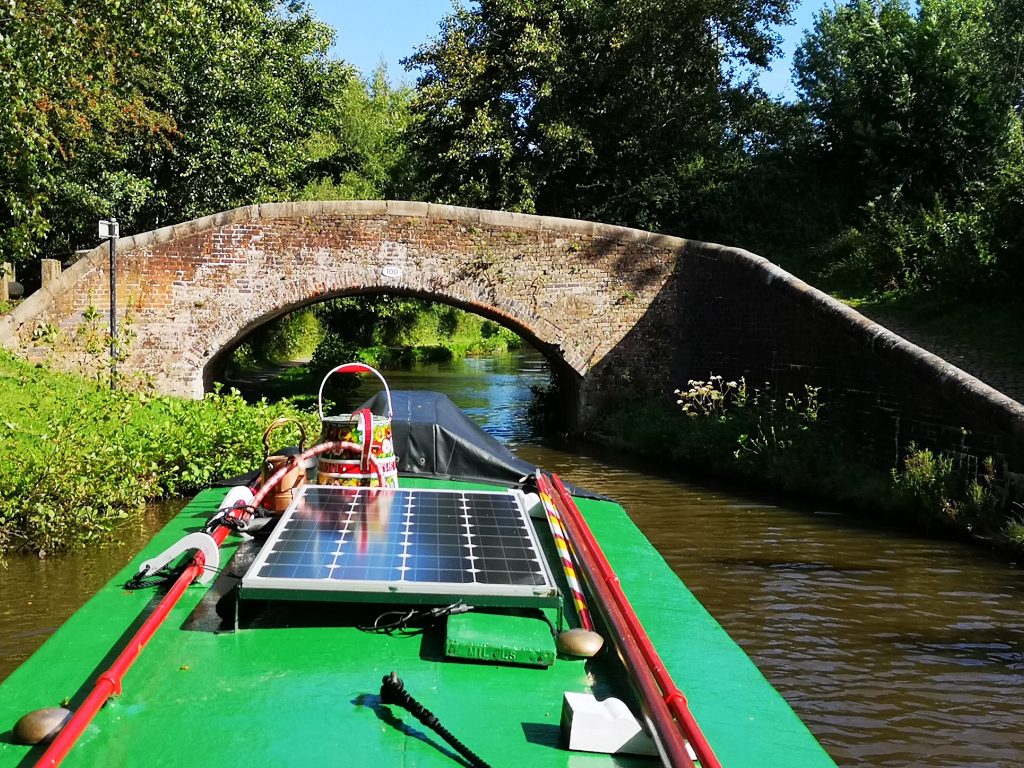
Sometimes marinas have launderettes but usually they require you to pay for an overnight mooring before you can use the facilities. This is fair enough but it makes for an expensive wash. One marina, I know of, does have a laundry room open to non-moorers. However, I must admit each time I use it, I lose the will to live.
The laundry is grim, the pump-out pipe passes through the room, so ensuring every time a boat empties its toilet tank a heady waft of human effluent fills the laundry room. Alongside the general ambience the two washing machines have minds of their own. They constantly reset, as a result a 30 minute wash takes 2 hours. Finally, the floor is filthy and as there is nowhere to fold clothes and sheets I end up standing on tip-toe trying to avoid dragging my newly clean bedding in the dirt. As the next laundry is another 2 weeks away I feel I have little choice but to use this horror!
Dreaming of a washing machine
With the ongoing challenge of dirty floors, expedition hikes, laundry zombies and the pandemic I must admit I have begun to fantasise about having a washing machine on the boat. This has obsessively filled my head, but I don’t think it will every happen.
Firstly, there’s the age old issue of space. When I am out on the canal for months every inch is filled with stock to sell from the boat. In addition to stock I still make sure I have food for the zombie apocalypse squirreled away. Secondly, the electrical set up of my 1973 boat means it doesn’t have the power for a washer of any sort. My old engine has a dynamo-starter, unlike modern boats it just doesn’t have the electrical power to run an inverter of a reasonable size to use 220v. The bottom line is that I will continue to haul my sheets across random towns. The challenge of clothes, doing the laundry and launderettes is real…
Footnote
*According to Bradshaw’s 1904 waterways guide a gongoozler is, ‘an idle and inquisitive person who stands staring for prolonged periods at anything out of the common. This word is believed to have its origin in the Lake District of England.’
Enjoyed reading this..far more thsn u enjoyed doing your laundry ?
Haha! The laundry crisis is real. I actually dreamt of washing machine last night. How sad is that?!
A very amusing post Kay, particularly liked the categorisation of your clothes and the laundry zombies – also well impressed with your detailed ‘flow diagram’ of appropriate boat clothes!
Great photo of Monte showing off his furry fitted trousers, or had he just eaten a whole box of Dreamies and was feeling rather full !
Thank you Clive! Maybe I need to be selling the flow diagram to people on small boats?! Yes, Monte definitely has a Dreamie pudding-stomach… ??. Hope to see you out and about soon.